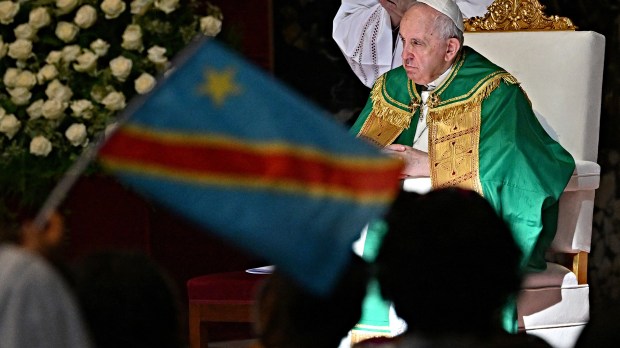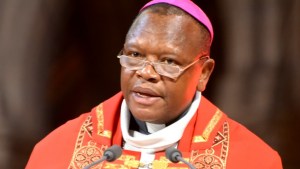One of the highlights of Pope Francis’ trip to the Democratic Republic of the Congo will be the Mass celebrated on February 1, 2023, in the presence of at least 120,000 people gathered on the tarmac of Ndolo airport in Kinshasa. The liturgy will incorporate elements of the Zairean rite, made possible by the Second Vatican Council. Its development required nearly two decades of work and dialogue between Rome and the Zairean episcopate. While some local liturgical rites exist in certain dioceses by virtue of older traditions, as for example with the Ambrosian rite in Milan, the Zairean rite represents, for the moment, a unique example of inculturation of the Catholic liturgy on a national scale.
The melodies of this rite, integrating elements specific to African culture into the Roman Catholic liturgy, have resounded twice under the vaults of St. Peter’s Basilica: on December 1, 2019, and more recently on July 3, 2022, during a Mass that was celebrated for the Congolese community in Rome to compensate for the postponement of the papal visit due to the pope’s health.
On June 20, 2022, the secretary of the dicastery for Divine Worship, Archbishop Vittorio Francesco Viola, mentioned the link frequently evoked by Pope Francis between “the commitment to the new evangelization” and “the inculturation of the liturgy.” He made his comments at a conference to present the French edition of Sister Rita Mboshu Kongo’s book, “Pope Francis and the Roman Missal for the Dioceses of Zaire,” published by the Vatican Publishing House.
The Italian Franciscan explained that “while being fully Roman, this Missal presents particular adaptations: the evocation of the ancestors at the beginning of the celebration, the penitential act after the homily, and the rite of peace after the penitential act.”
In a message sent on the occasion of the presentation of this book, Pope Francis described the Zairean Rite, also called the “Congolese Rite,” as a “model for other Churches seeking an appropriate liturgical expression to bring to maturity the fruits of the missionary enterprise of evangelization of cultures and inculturation of the Gospel.”
Echoes as far as the Amazon
Archbishop Viola drew a parallel between the development of the Zairean rite and the idea of a rite proper to the Amazon, a theme raised at the Synod of 2019. In his exhortation Querida Amazonia, the Pope asked that “cultural heritage be put to good use in the search for a liturgy that can work in an effort for the inculturation of indigenous peoples,” he recalled.
Archbishop Viola said that inculturation is the “new frontier” of the liturgical reform that came out of the Council. During the Second Vatican Council, the Constitution Sacrosanctum Concilium, in fact, opened the possibility of adapting the liturgy to local cultures, specifying that the Church “does not wish to impose the rigid form of a single wording even in the liturgy: on the contrary, she cultivates the qualities and gifts of the various peoples.”
“Provisions shall also be made, when revising the liturgical books, for legitimate variations and adaptations to different groups, regions, and peoples, especially in mission lands, provided that the substantial unity of the Roman rite is preserved,” specified the Council Fathers in this text, which was approved with a very large consensus (2,158 votes in favor and only 19 votes against).
For the moment, the Zairean rite remains the only concrete example of this liturgical inculturation. The elaboration of a potential “Amazonian Use” remains “on the high seas,” acknowledged Archbishop Viola, mentioning as a concrete action to date the simple setting up of a commission to reflect on the feasibility of such a step.
Staying in communion with Rome to avoid becoming a sect
In the years of intellectual and liturgical turmoil that followed the Second Vatican Council, the Congolese episcopate was careful to maintain full communion with the Successor of Peter. “To be Catholic, the Eucharistic liturgy that we celebrate in Zaire must justify its apostolic origin. Otherwise, we would become a sect,” said the country’s bishops who were involved in promoting the Zairean rite.
The Dicastery for Divine Worship and the Discipline of the Sacraments has therefore played – and still plays – a central role in accompanying these efforts. From 1969 to 1988, an intense and frequent dialogue was conducted under the impulse of Cardinal Joseph-Albert Malula (1917-1989), Archbishop of Kinshasa for 25 years. This central figure for the post-colonial Church in Africa was appointed by John XXIII as a member of the preparatory liturgical commission for the Second Vatican Council. He then went on to determine with his Congolese confreres a method for “seeking an African and Zairean framework” in the adaptation of the Roman Missal edited by Paul VI.
A slow process of nearly two decades took place between the local episcopate’s request in 1969 and the approval of this Roman Missal for the dioceses of Zaire in 1988. The dicasteries for Divine Worship and for the Doctrine of the Faith studied the celebrations conducted ad experimentum. In the 1980s, Cardinal Joseph Ratzinger himself went to Zaire to observe the implementation of this liturgy and to make observations.
Sister Rita Mboshu Kongo said her study of “the reception and adaptation of the conciliar liturgy in the Democratic Republic of the Congo” was, for some, “a source of curiosity” and for others, “a reason for reawakening.”
The Zairean rite has been abandoned in some parishes and dioceses, especially because of the ethnic and linguistic complexity of this immense country.
“This rite has evolved, like a human body that is born and needs to develop,” added the Congolese theologian, noting that “it is this evolutionary character that plunges us into history, to understand that it is a laborious work of the second evangelization of the Congo.”


